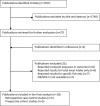Fish intake and risk of liver cancer: a meta-analysis
- PMID: 25615823
- PMCID: PMC4304705
- DOI: 10.1371/journal.pone.0096102
Fish intake and risk of liver cancer: a meta-analysis
Abstract
Background: Increasing laboratory findings indicate that n-3 fatty acids, mainly derived from fish, inhibit cancer development and progression, but results from epidemiologic studies have been inconsistent and inconclusive.
Objective: To evaluate the association of fish intake with risk of liver cancer by conducting a meta-analysis.
Methods: Published case-control/cohort studies that evaluated the relationship between total fish intake and risk of liver cancer were found on PubMed and EMBASE. The pooled relative risks (RRs) with 95% confidence intervals (CIs) were obtained with the random-effects model.
Results: Five retrospective case-control studies and 5 prospective cohort studies were included in the final analysis, involving a total of 3 624 liver cancer cases. Comparing the highest with the lowest category of total fish intake, the pooled RRs of liver cancer were 0.79 (95% CI, 0.59-1.06) for case-control studies, 0.82 (95% CI, 0.70-0.96) for cohort studies and 0.82 (95% CI, 0.71-0.94) for all studies combined. The protective effects of total fish intake against liver cancer were confirmed by stratified and sensitivity analyses. In addition, an increase in fish intake of 1 serving/week was estimated to be significantly associated with 6% lower risk of liver cancer (RR = 0.94, 95% CI, 0.91-0.98).
Conclusions: Findings from this meta-analysis suggest that a higher fish intake is associated with reduced risk of liver cancer.
Conflict of interest statement
Figures



References
-
- Bosch FX, Ribes J, Diaz M, Cleries R (2004) Primary liver cancer: worldwide incidence and trends. Gastroenterology 127: S5–S16. - PubMed
-
- Llovet JM, Burroughs A, Bruix J (2003) Hepatocellular carcinoma. Lancet 362: 1907–1917. - PubMed
-
- El-Serag HB, Mason AC (2000) Risk factors for the rising rates of primary liver cancer in the United States. Arch Intern Med 160: 3227–3230. - PubMed
-
- Yu MC, Yuan JM (2004) Environmental factors and risk for hepatocellular carcinoma. Gastroenterology 127: S72–78. - PubMed
Publication types
MeSH terms
LinkOut - more resources
Full Text Sources
Other Literature Sources
Medical

